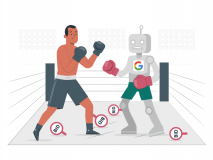What if I told you that most DTC brands are paying 10 times more than they need to for branded search clicks? Clicks you were probably going to get anyway. It sounds like an exaggeration, but I see it constantly.
Before I break down the why, let me show you what I mean. Here’s a recent account where we isolated branded keywords into their own campaign with a new bidding strategy. The moment we made the change, the cost per conversion plummeted from a volatile $33-$56 range to a steady $6. We actually got more conversions the first week, and the slight dip afterward was just normal seasonality for this business.
Here’s another one. We were spending 2,000-3,000 kr. per week on branded search. I dropped the CPCs manually, and spend fell to just a few hundred kr. The key takeaway? Clicks didn’t drop. The performance dip you see later was again, just seasonality. The volume came right back up.
The problem is we’ve all been taught that you must defend your branded traffic at all costs. It seems obvious, right? Someone searches for your brand, you want to make sure they land on your site. But this mindset gets expensive, fast—especially if you don’t understand how to manage your bids properly in Google Ads.
Go Beyond the Article
Why the Video is Better:
- See real examples from actual client accounts
- Get deeper insights that can’t fit in written format
- Learn advanced strategies for complex situations
The Expensive Mindset: Why We Overpay for Branded Clicks
First, you need to understand which group your brand falls into, because the strategy is different.
Group 1: No Outside Distribution. You are the only one selling your products. You aren’t on marketplaces that bid on your brand terms, and you don’t have wholesale partners bidding on your name. Your only job is to defend your position against competitors selling different products.
Group 2: With Outside Distribution. You sell through other retailers or marketplaces. Now, you’re competing with partners selling your own product in addition to your regular competitors. This is a more delicate situation.
Both of the examples I showed you were from Group 1. By simply switching to manual bids, we saw a 10x drop in cost per conversion. The issue in both cases wasn’t competition; it was a flawed bidding strategy.
Smart Bidding Isn’t Built for Your Brand. Here’s Why.
This is where things go wrong for most advertisers. They assume Smart Bidding is the answer for everything. It’s not.
The problem is twofold:
- Smart Bidding maximizes for volume, not efficiency. It’s designed to get you as many conversions as possible within your target. For branded search, where you have a captive audience, this is overkill.
- It will always bid up to your target. Even with a high ROAS target, Smart Bidding won’t try to minimize your spend. If it can get a conversion at your 800% tROAS target, it will, even if that same conversion was available for a bid that would have produced a 4,000% ROAS.
You’re essentially telling Google, “Here’s my credit card, spend whatever it takes to hit this number,” when you could be getting the same results for a fraction of the cost. You’re in a bidding war against yourself for no reason.
How to Properly Manage Your Branded Search Bids
For branded search, you want to strip things back to basics. You need simplicity and direct control. Here’s how.
Step 1: Isolate and Simplify Your Structure
First, pull all your branded keywords into their own dedicated search campaign. Don’t lump them in with your generic campaigns. This gives you a clean environment to control spend and measure performance accurately.
Step 2: Switch to Manual Bids (Yes, Really)
This is the big one. For your dedicated brand campaign, use manual bids. This gives you direct control over your CPCs, which is exactly what you need. The only other viable option is Target Impression Share, but you must use it with a maximum CPC bid limit. Don’t just set it to 100% and let Google run wild; you’ll end up in the same overspending situation.
Step 3: Test, Test, and Test Again
Once you have direct control, you can optimize easily. The ideal scenario, which I see all the time, is that clicks remain stable while your CPCs drop by half (or even 10x). But you have to test to find that floor. If you lower your bids and see clicks or conversions drop, you’ve found your minimum bidding threshold against competitors. Just bid back up slightly. Way too many advertisers never, ever test this—they just set a high bid and forget it.
What About Branded Shopping? A More Complicated Beast
The optimal bidding structure for branded Shopping gets a bit more complicated.
- If you have a few products, manual bidding can still work just fine.
- If you have thousands of SKUs, you should consider Smart Bidding but with strict controls. Running manual bids on thousands of individual products is a nightmare unless you have a very specific skillset (and honestly, very few people do anymore). You’ll likely mess it up and send too much traffic to low-selling products.
The key is that even when using Smart Bidding for branded Shopping, you still need those performance guardrails. Set a max CPC limit. Use a very high tROAS target. The principles are the same, even if the execution is slightly different due to product volume.
Two Red Flags That You’re Overspending (Right Now)
Before you even start testing, you can do a quick gut check. These aren’t hard rules, but if your account fits these descriptions, you are almost certainly overspending.
Red Flag #1: You spend more than 10% of your total ad budget on your brand. This is a huge red flag. Unless you are in an insanely competitive market, your brand spend should be a small fraction of your overall budget.
Red Flag #2: Your branded ROAS is less than 2x your generic ROAS. If your generic campaigns are getting a 500% ROAS and your branded campaigns are at 800%, something is wrong. Either you’re being way too aggressive on brand, or you’re not being aggressive enough on generic. Your branded ROAS, especially on search, should typically be 8x, 10x, or even 20x+ higher than generic.
How to Run an Experiment to Find Your Optimal Bid
The only way to know for sure if you’re overpaying is to run an experiment in Google Ads. It’s the perfect tool for this job.
- In your Google Ads account, go to Campaigns and then click on Experiments.
- Create a new custom experiment, select “Search,” and choose your branded search campaign as the base campaign.
- In the trial campaign settings, go to your keywords and change the max CPCs. Try lowering them by 25% to start (e.g., from $1.00 to $0.75).
- Set up the experiment schedule. I recommend a 50/50 traffic split. Set your success metrics: you want to track that the number of clicks sees “no significant change” while the cost “decreases.”
- Enable sync so any changes you make to ads in the original campaign are copied over. Then click Create experiment.
Let it run, track the impact, and then rinse and repeat. This is how you dial in the perfect bid instead of just guessing.
Two “Off-Platform” Ways to Lower Your Brand Spend
Sometimes, the best moves happen outside of your Google Ads account.
First, try to avoid paying at all. If a few competitors are bidding on your brand, just reach out to them. Most business owners don’t want to waste money on a click war. This is a much bigger thing in Europe than in the US, but it’s always worth a shot. For distributors, it’s more delicate, but you can still ask them to stop bidding on your brand terms. Some will happily agree.
Second, don’t obsess over being number one. I have this conversation with brand owners all the time. You do not need to be in position one for your own brand 100% of the time. If you drop from a 99% top impression share to 95% but save 50% on your CPCs, that’s a massive win. Overbidding on your own name is like paying Google a free tax. The only ones who benefit are your competitors.
[TL;DR]
- A 10x cost difference is real. Don’t assume Smart Bidding is the cheapest or most efficient way to manage your branded search campaigns.
- If you compete with distributors, treat your branded terms more like highly valuable generic keywords and bid accordingly—with strict controls.
- Use the Experiments feature in Google Ads. It is the only reliable way to A/B test your bids and find the optimal spend for your brand.
- Repeat your experiments. Re-run these tests twice a year or anytime your auction landscape changes (e.g., new competitors, new wholesale partners).
So, the action from here is simple: go look at your brand performance. Ask yourself if you’re hitting any of the red flags I mentioned. And if you are, start an experiment. It’s the fastest way to get real data on what happens when you lower your bids. You might be surprised by how much money you can save.









